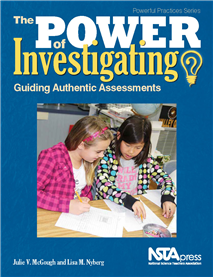Explore the Power of Investigating
By Carole Hayward
Posted on 2017-05-28
 How can a teacher build and maintain a learning environment that will help students investigate meaningful questions? That’s the central question of The Power of Investigating: Guiding Authentic Assessments by Julie V. McGough and Lisa M. Nyberg.
How can a teacher build and maintain a learning environment that will help students investigate meaningful questions? That’s the central question of The Power of Investigating: Guiding Authentic Assessments by Julie V. McGough and Lisa M. Nyberg.
The pedagogical picture book for K–5 teachers provides practical advice for building investigations that integrate both STEM and literacy skills. It’s the second book in the NSTA Press Powerful Practices series.
Investigations serve to enrich the curriculum and make it real for students. “Hands-on, meaningful investigations give life to learning, inspire questions, and engage students and teachers in thinking,” McGough and Nyberg explain in Part 1. From words and images on a page to active engagement, investigations transform learning experiences from being two-dimensional to being three-dimensional.
The book focuses on how teachers can use investigations to support a curriculum aligned with the science and engineering practices, disciplinary core ideas, and crosscutting concepts that are outlined in the Next Generation Science Standards (NGSS).
“The Powerful Practices instructional model provides a canvas to integrate the questions, investigations, and assessments that help teachers and students make sense of the content. Integration of those three components offers a means to engage students and teachers in the dynamic experience of life and learning,” the authors write.
The Power of Investigating offers valuable insights, including practical strategies for helping young scientists investigate meaningful questions and communicate their findings, ideas for finding the resources you need to undertake investigations in your classroom, models of five types of investigations that can help to improve your students’ literacy skills, and tips for maximizing instructional time by integrating the NGSS, Common Core State Standards, your state’s science standards, and best practices in STEM education.
The book mixes text, lesson ideas, photos, and activities with video clips that you can access using a QR code. For example, in Part 1, students learn about worms. In their science journals students can record their initial observations. They can make closer observations using a microscope to study the features of the worm, noticing the worm’s rings, the texture of its skin. Students can draw pictures of their observations and read a nonfiction text that introduces concepts and vocabulary. Then, in a class discussion students can share their observations and ask questions, like “What are the lines on a worm for?” or “How do worms move without feet?” Also, the bonus video explains how three-dimensional learning experiences can help to build literacy skills.
The worm investigation allows students to learn while getting their hands dirty. It’s fun and engaging and guaranteed to be more memorable than just skimming a page in a textbook.
Learn more by reading the sample chapter, “How Do I Integrate Investigations?”
This book is also available as an e-book.
Save Now on Book Purchases!
Between now and May 31, 2017, save $15 off your order of $75 or more of NSTA Press books or e-books by entering promo code BOOK17 at checkout in the online Science Store. Offer valid only on orders placed of NSTA Press books or e-books on the web and may not be combined with any other offer.
Disclaimer: The views expressed in this blog post are those of the author(s) and do not necessarily reflect the official position of the National Science Teaching Association (NSTA).

